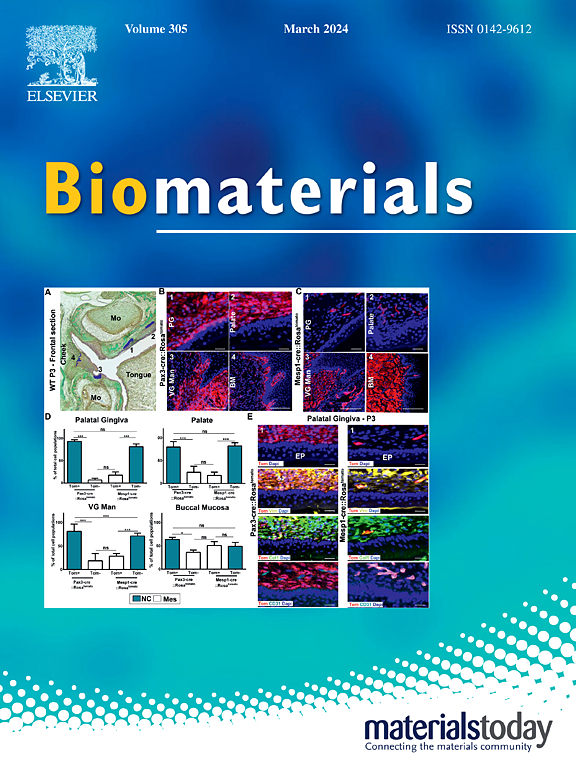一种用于血管化骨组织混合生物打印的刚性生物墨水,具有增强的机械性能
IF 12.8
1区 医学
Q1 ENGINEERING, BIOMEDICAL
引用次数: 0
摘要
生物3D打印是组织工程领域的一项新兴技术,它有利于制造复杂的组织。然而,挑战出现在生物打印功能,植入式组织。通常使用的水凝胶生物墨水,虽然提供理想的印刷性和细胞友好的环境,但往往缺乏打印后成熟,处理和植入所需的机械稳健性。这些限制与骨组织尤其相关。创伤或感染导致的骨质流失的治疗是一个重大的临床挑战。虽然存在手术干预,但它们经常导致并发症和有限的结果。因此,需要一种策略来增强与细胞兼容的生物打印结构的机械完整性。本研究提出了一种新的混合生物打印方法来创建机械健壮的血管化骨组织。由聚(乳酸-羟基乙酸)酸(PLGA)、羟基磷灰石(HA)和聚乙二醇微颗粒混合物组成的增强生物链接,由于玻璃化转变温度降低(~ 36℃)而具有热敏性,能够在生理条件下烧结,与细胞负载的ecm基水凝胶共打印。微粒在37℃下烧结,形成多孔的、坚硬的支架。混合生物打印结构显示出高细胞活力,血管网络形成和成骨分化。与脱细胞对照相比,在大鼠股骨缺损的体内植入显示出更好的骨再生。这项研究强调了混合生物打印在创造具有高细胞活力和增强机械性能的组织方面的潜力,允许它们的处理和植入。本文章由计算机程序翻译,如有差异,请以英文原文为准。
A stiff bioink for hybrid bioprinting of vascularized bone tissue with enhanced mechanical properties
3D bioprinting is an emerging technique in tissue engineering that is advantageous for fabricating intricate tissues. However, challenges arise in bioprinting functional, implantable tissues. Commonly utilized hydrogel bioinks, while offering desirable printability and a cell-friendly environment, often lack the mechanical robustness necessary for post-printing maturation, handling, and implantation. These limitations are particularly relevant for bone tissue. Treatment of bone loss resulting from trauma or infection poses a significant clinical challenge. While surgical interventions exist, they frequently lead to complications and limited outcomes. Thus, a strategy to enhance the mechanical integrity of bioprinted constructs compatible with cells is needed. This study presents a novel hybrid bioprinting approach to create mechanically robust, vascularized bone tissue. A reinforcing bioink composed of a poly(lactic-co-glycolic) acid (PLGA), hydroxyapatite (HA), and polyethylene-glycol microparticles blend, which is thermosensitive due to a reduced glass transition temperature (∼36 °C), enabling sintering at physiological conditions is co-printed with a cell-laden, ECM-based hydrogel. The microparticles sinter at 37 °C, forming a porous, stiff scaffold. The hybrid bioprinted constructs demonstrate high cell viability, vascular network formation, and osteogenic differentiation. In vivo implantation in a rat femoral defect reveals superior bone regeneration compared to acellular controls. This study highlights the potential of hybrid bioprinting for creating tissues exhibiting high cell viability and enhanced mechanical properties, allowing for their handling and implantation.
求助全文
通过发布文献求助,成功后即可免费获取论文全文。
去求助
来源期刊

Biomaterials
工程技术-材料科学:生物材料
CiteScore
26.00
自引率
2.90%
发文量
565
审稿时长
46 days
期刊介绍:
Biomaterials is an international journal covering the science and clinical application of biomaterials. A biomaterial is now defined as a substance that has been engineered to take a form which, alone or as part of a complex system, is used to direct, by control of interactions with components of living systems, the course of any therapeutic or diagnostic procedure. It is the aim of the journal to provide a peer-reviewed forum for the publication of original papers and authoritative review and opinion papers dealing with the most important issues facing the use of biomaterials in clinical practice. The scope of the journal covers the wide range of physical, biological and chemical sciences that underpin the design of biomaterials and the clinical disciplines in which they are used. These sciences include polymer synthesis and characterization, drug and gene vector design, the biology of the host response, immunology and toxicology and self assembly at the nanoscale. Clinical applications include the therapies of medical technology and regenerative medicine in all clinical disciplines, and diagnostic systems that reply on innovative contrast and sensing agents. The journal is relevant to areas such as cancer diagnosis and therapy, implantable devices, drug delivery systems, gene vectors, bionanotechnology and tissue engineering.
 求助内容:
求助内容: 应助结果提醒方式:
应助结果提醒方式:


